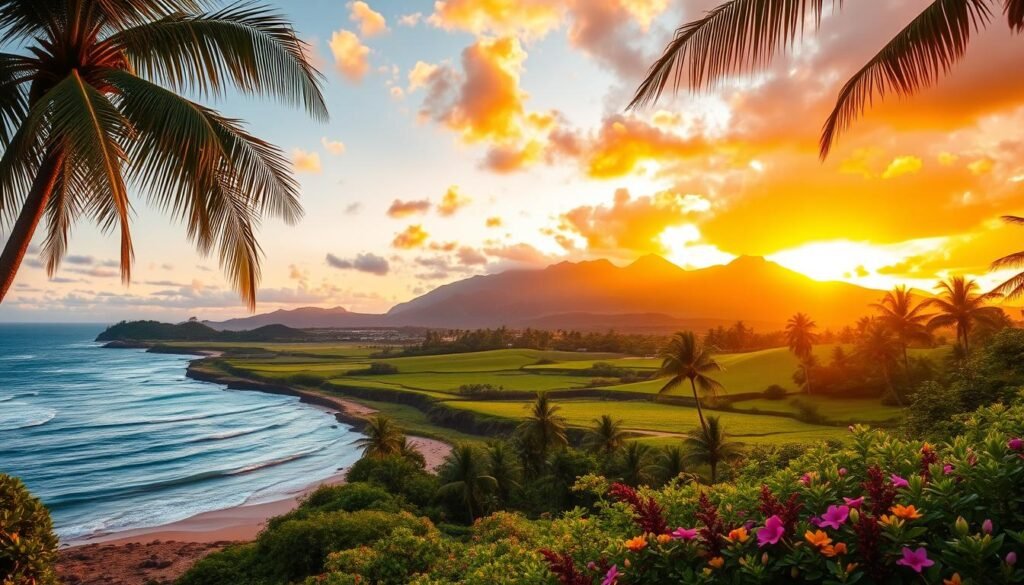Surprising fact: about 60% of U.S. travelers pick mid‑winter or summer months, driving peak crowds and higher hotel rates across the islands.
I wrote this article so you can plan your trip with calm, not guesswork. I walk through how the islands’ weather and seasons shift across the year, and why early November and late March often hit the sweet spot for value and sun.
Hawaii’s trade wind showers tend to pass quickly, and temperatures usually sit between the mid‑60s and mid‑80s depending on elevation. Peak demand runs mid‑December through March and mid‑June through August, while spring and fall are quieter with more deals and fewer crowds.
I’ll also cover surf energy, festival highlights, and planning basics—like how the June–November hurricane season rarely produces direct hits—so you can pick the right months and enjoy the island experiences you want.
Key Takeaways
- Early November and late March offer strong value with good weather and lighter crowds.
- Summer and winter draw the most visitors, affecting hotels and reservations.
- Trade wind showers are brief—rain rarely ruins a day at the beach.
- Temperatures vary by elevation; pack layers for higher spots.
- Spring and fall are great for deals and calmer islands.
My TL;DR on the best time visit: sweet spots, seasons, and what I prioritize
If you want a quick roadmap for planning, here’s my short take on when the islands line up best for your goals.
Early November and late March are my top picks for value. Flights and rooms dip, the sun still shows up, and reservations are easier.
For pure beach weather, summer is driest and warmest, but it draws more visitors and larger crowds at major attractions. Winter brings surf events and whales, yet it also means holiday spikes and tighter availability.You can learn more about best-time-to-visit-costa-rica
Shoulder months in spring and fall strike a balance: reliable temperatures, calmer seas, and better deals than peak months.
- I book refundable fares and watch airfare trackers early.
- I lock rental cars before peak periods sell out.
- Pick a month based on your priority: hikes, snorkeling, or festivals.
| Season | Weather | Crowds | Why I’d pick it |
|---|---|---|---|
| Early Nov / Late Mar | Sunny, mild temperatures | Lower | Best value, easier reservations |
| Summer | Warmest, dry | High | Top beach weather, family travel |
| Winter | Cooler at elevation, big surf | High | Events, whale watching, busy calendars |
Understanding Hawaii’s weather year-round: trade winds, showers, and sunshine
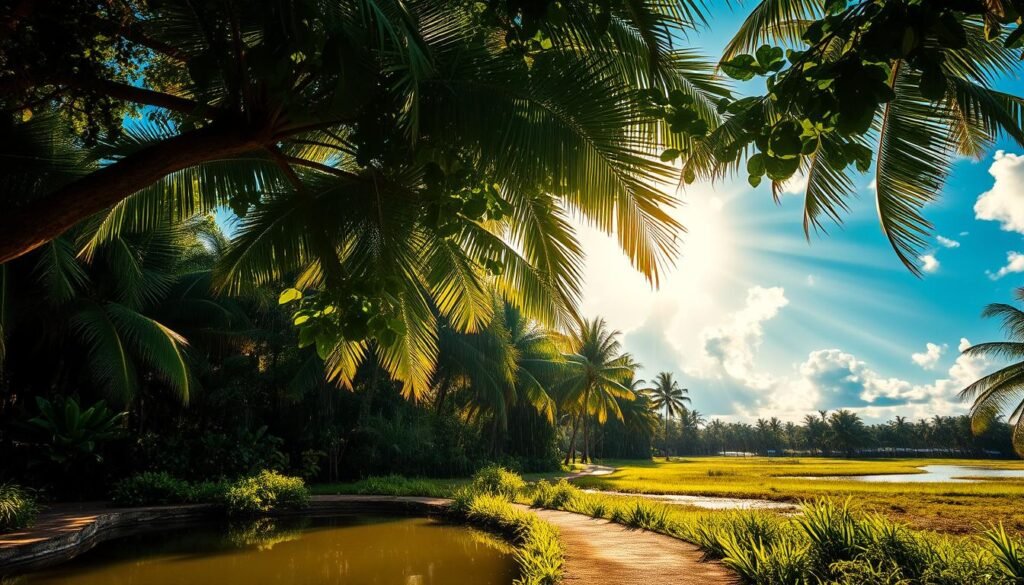
Understanding local wind and cloud patterns helps you salvage a beach day almost every visit. I break the basics down so forecasts make sense and you can plan with less stress.
What “trade wind showers” really mean for your beach day
When a forecast shows rain for several days, that often signals quick trade wind showers, not an all-day downpour. These bursts usually pass overnight or in the early morning, leaving wide open afternoons for sun and sand.
Trade winds sweep clouds through fast; if they stall, you may see Kona weather—short stretches of hot, humid air instead.You can learn more about best-time-to-visit-yellowstone
Temperature ranges and how elevation changes your experience
Expect temperatures roughly from the mid‑60s to mid‑80s Fahrenheit. The warmest water and air show up in August–September, while the rainiest stretch runs November–January.
Elevation matters. High summits can be chilly, so I pack a light layer for crater nights or sunrise hikes. Rainfall is very local—one beach may get a sprinkle while another is sunny minutes away.
- I read icons knowing brief showers are common, and I build plan B coves into my days.
- May–September is the driest run, great for long beach or hike days.
- Water clarity peaks in late summer, a boost for snorkeling and calm conditions.
In short, the island’s weather is steady through the year. Learn the patterns and you’ll shape a better experience on the fly.
High, shoulder, and low seasons: how crowds shift through the year
Crowd levels on the islands swing dramatically through the year, and that affects prices, parking, and how you plan each day.
Winter and summer surges
Winter and summer surges: snowbirds and school holidays
High season runs mid‑December through March and mid‑June through August. These months draw snowbird escapes and families on break.
Expect higher rates, minimum stays, and stricter hotel policies around Christmas and New Year. Rental cars can sell out unless you book early.You can learn more about best-time-to-visit-italy
Spring and fall lulls
Spring and fall lulls: fewer visitors, easier reservations
Off‑season windows — April to mid‑June and September to mid‑December — offer calmer crowds and more flexible reservation options.
I often choose these months for better availability, fewer lines, and easier parking at popular sites. Major events can still create small spikes, so I check the calendar before locking plans.
- I map the crowd curve: winter and summer are peak season for island travel.
- Spring and fall bring quieter conditions and smoother logistics for visitors.
- If you want energy and full event rosters, plan early for holiday and summer months.
| Season block | Typical months | Crowds | What shifts |
|---|---|---|---|
| High season | Mid‑Dec — Mar; Mid‑Jun — Aug | High | Higher prices, minimum stays, tight car inventory |
| Shoulder season | Apr — Mid‑Jun; Sep — Mid‑Dec | Lower | Better availability, fewer lines, lower rates |
| Micro‑peaks | Major events & holidays | Variable | Local spikes; book around festivals and contests |
best time to visit hawaii for value: early November and late March
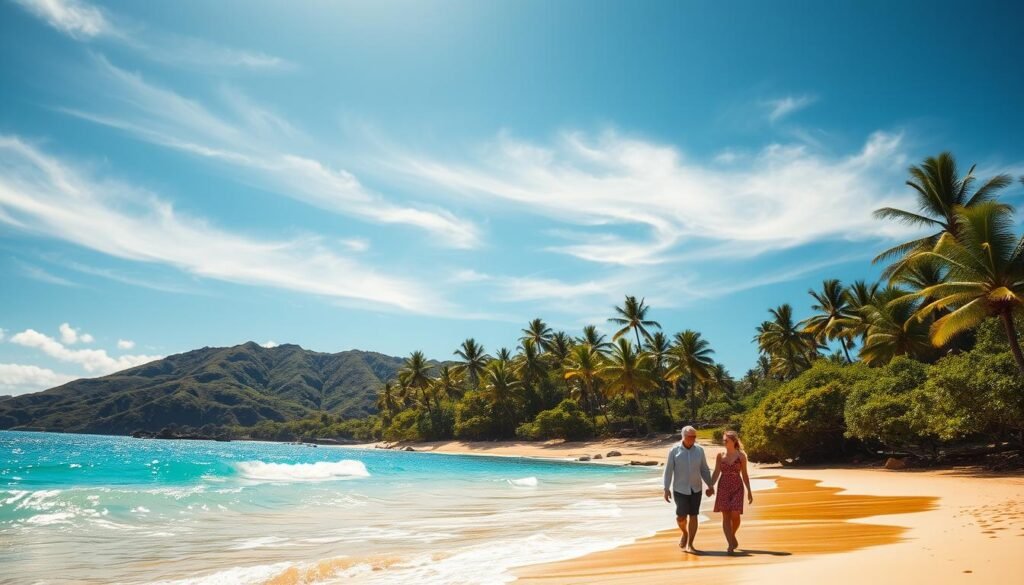
I pick two narrow windows of the year where value and weather line up better than most other weeks.
Early November and late March give many of summer’s sunny days without the peak pricing. Airfare and hotel rates usually dip, while island temperatures stay pleasant for beaches and hikes.
- I target early November and late March because fares and rooms trend lower while conditions remain beach‑friendly.
- These spans sit between winter and summer surges, so cars, catamarans, and oceanfront rooms are easier to book.
- Day‑to‑day logistics are calmer: shorter lines, fewer sold‑out activities, and simpler dinner reservations for most visitors.
- Temperatures are steady enough for morning snorkeling, scenic drives midday, and breezy sunset sails.
- For families, these months sidestep the priciest school breaks and still offer sun and lighter crowds.
I set flight alerts 2–4 months ahead and pounce when prices drop. If you shift by a few days and travel midweek, you’ll often find stronger deals and better opportunities on the island.
Bottom line: these shoulder edges are my best time picks for value without gambling on rough weather or heavy crowds.
The cheapest time to visit hawaii: flights, hotels, and smarter booking
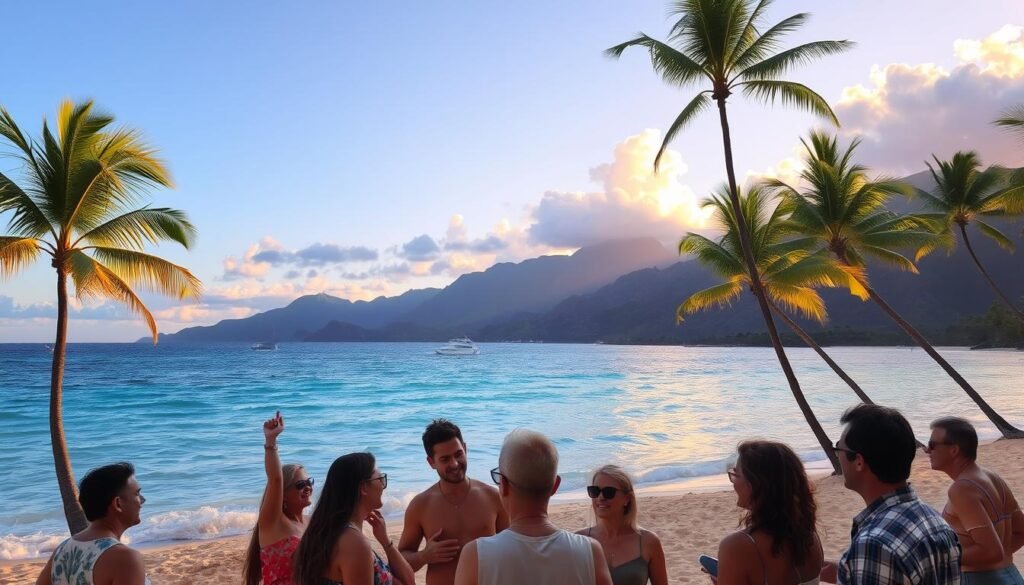
Finding low rates is less about luck and more about watching cycles and booking smart.
I track airfare and hotel rhythms so I don’t overpay for a trip. Airfares spike in January and stay elevated through winter, and summer fares run high as well. In my experience, late November and early March offer solid purchase windows for tickets.You can learn more about best-time-to-visit-ireland
Airfare trends and when I buy
I usually lock flights 2–4 months before departure. That window beats last‑minute gambles and often nets better fares even in shoulder months. I use price alerts and shift dates by a day or two for savings.
Hotel patterns by location
Hotel rates vary widely by island and city. In Honolulu, January is the priciest month while April can be up to 22% cheaper at similar properties. On Maui’s west coast, Lahaina can swing nearly a third between February and September.
| Category | Typical high | Typical low | Booking tip |
|---|---|---|---|
| Airfare | January, Summer | Late Nov, Early Mar | Set alerts; buy 2–4 months out |
| Honolulu hotels | January | April | Check weekday stays and loyalty promos |
| Lahaina hotels | February | September | Compare resorts and flexible cancellation |
Practical approach: I tally flights, hotel, car, and fees before I book. Small savings across each category often beat hunting one big deal. Also, check event calendars; festivals can flip usual low‑price months.
Best time to go by activity: surf, whale watching, hiking, snorkeling
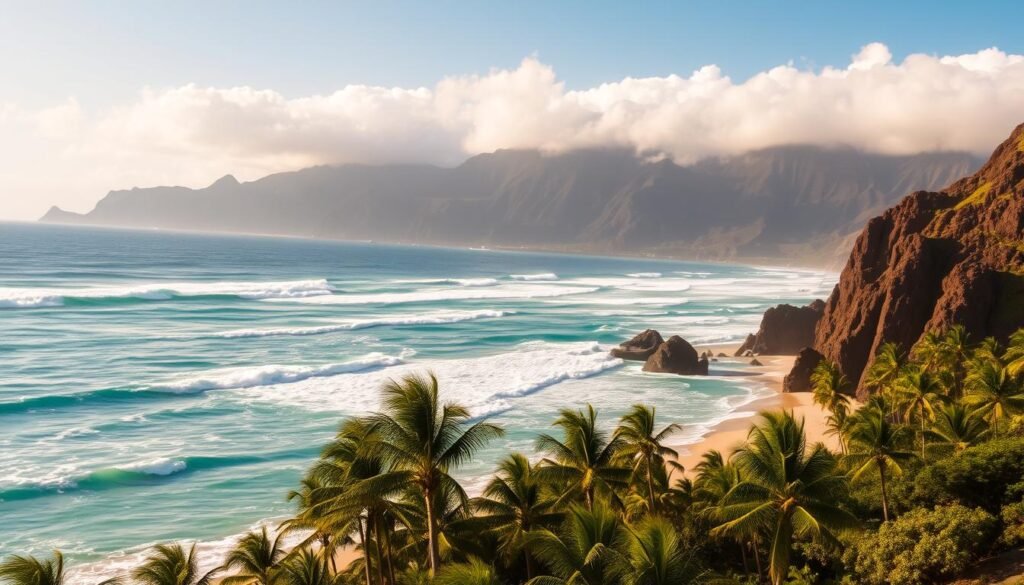
Different island activities peak in distinct months, so I pick dates around what I want to do most.
North Shore surf peaks and where beginners should start
Winter brings big north and west swells that create iconic surf energy on the North Shore. Pros and contests thrive then.
If you’re learning, I point you toward summer south-facing breaks. Waikīkī and other gentle reefs offer long, forgiving rollers for first waves.
Whales, waterfalls, and trail conditions
Whale watching soars in winter into early spring, with February standing out for sightings and events.
Rainier months refill waterfalls and green valleys. I check recent rainfall and pick well-drained routes after heavy showers.
Snorkeling clarity and warmest ocean months
Snorkeling is sweetest when seas are calm and clear. Late summer into early fall—September in many spots—gives the warmest water and top visibility.
- Surf: winter for pro energy; summer for beginners.
- Whales: winter–early spring, February is peak for cruises.
- Hiking: spring and fall for drier trails; rainy months for lush waterfalls.
- Snorkel: late summer/early fall for warm water and clear conditions.
Quick tip: If you want to mix surf, snorkel, whales, and hikes, I aim for shoulder months — they give the most flexible daily experience.
Month-by-month guide: what each time of year really feels like
Each month on the islands brings a distinct mood — from surf drama to festival parades. Use this quick quartered view to match weather, events, and daily energy with your plans.
January–March
January through March bring cooler air at elevation and sporadic showers along windward coasts.
Big north and west swells roll in, drawing surf contests and crowds on famous breaks. Whales peak and festivals like Chinese New Year and the Honolulu Festival fill calendars.
April–June
April through June leans sunny and dry. Seas calm up, which makes these months ideal for snorkeling, sailing, and long beach days.
Cultural events — Lei Day, SPAM JAM, Lantern Floating — add flavor without the heavy crowds seen in high season.
July–September
July through September is pure summer energy with the warmest ocean temps and gentle south-shore surf for learners.
Expect festivals like Aloha and Okinawan celebrations, evening swims, and balmy days that stretch late into dusk.
October–December
October through December brings fall festivities and the holiday crescendo. Rains return, but many showers pass quickly and leave rainbows behind.
Major draws include the Hawai‘i Food & Wine Festival, the Vans Triple Crown, and holiday lights — plan ahead for higher demand days.
“Map events and sea conditions before you book; choosing a quieter weekday can save money and hassle.”
- Quick tips: I map key events into each quarter and flag likely busy days so I can book earlier or pick midweek travel.
- Use this guide to choose a month, then dive deeper into the specific monthly breakdowns that follow or check practical planning resources like this planner.
Hawaii in January to March: waves, whales, and cultural moments
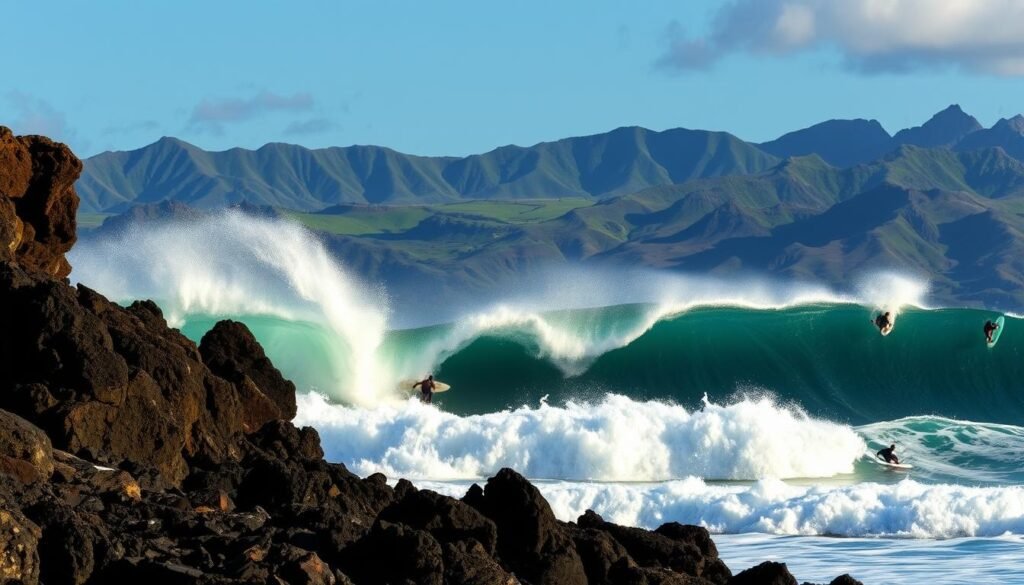
From big surf lines to whale sightings, January through March packs a lot into each coastal day. I find this stretch rich with contrast: powerful ocean scenes, lively festivals, and weather that shifts fast.
January sets the tone. The north shore and west coasts light up with marquee surf competitions. Chinese New Year often fills streets and plazas with color. Expect highs in the mid‑60s to 70s, cooler mornings and some passing rain.
February highlights
February keeps swell energy and turns attention to whales. World Whale Day events and the POW! WOW! Hawaii arts festival bring crowds and culture. Rain can pick up, so I watch forecasts and plan flexible indoor stops.
March highlights
March eases showers and maintains lively swells. The Honolulu Festival and the Kona Beer Festival add music, food, and craft brews. For families, I recommend morning whale tours for calmer water and gentle beach afternoons.
- I aim for early coastal drives and lookout stops to beat parking shortages.
- Pack a light rain layer and a towel in the trunk—quick showers often clear into rainbows.
- These months are my pick if you want culture, whales, and world‑class surf viewing without needing a calm beach every day.
| Month | Main draws | Weather notes |
|---|---|---|
| January | North Shore surf contests, Chinese New Year | Cool mornings; some rain; dramatic surf |
| February | World Whale Day, POW! WOW! Hawaii | More rain; peak whale season; lively arts |
| March | Honolulu Festival, Kona Beer Festival | Less rain than Feb; steady swells; mild temps |
Hawaii in April to June: driest days and signature celebrations
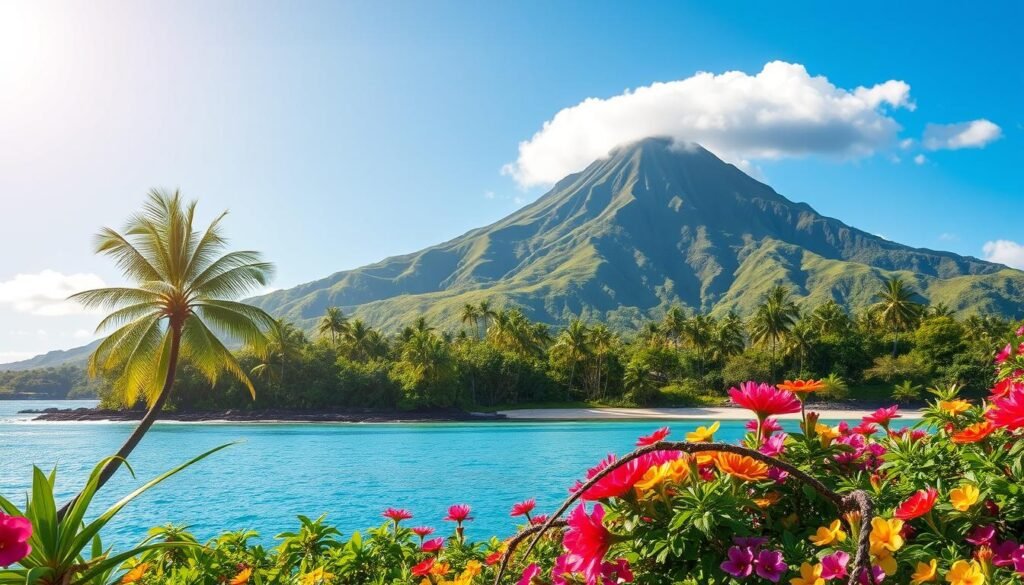
This spring window usually gives the clearest weather and a string of signature celebrations across the island. April through June is often the driest, sunniest stretch of the year and it’s perfect for outdoor plans.
April: street food and craft beer
April typically kicks off the dry run. I love timing a visit for the Waikiki SPAM JAM street party and the Honolulu Brewers Festival. Both pair well with calm seas and long beach afternoons.
May: lei traditions and lanterns
May brings Lei Day celebrations across the island and the Lantern Floating Ceremony on Memorial Day. These events feel intimate and deep, and they make evening plans especially meaningful.
June: parades and international flavor
June keeps the sunny streak going with King Kamehameha Day parades and the Pan Pacific Festival. The festival often features 100+ performances, so I block extra calendar time for shows and food booths.
- Calmer seas and bright days mean I stack snorkeling, sunrise hikes, and sailing in these months.
- Daytime temperatures feel warm but not oppressively humid—great for long outdoor experiences.
- I recommend booking dinner to match festival nights and leaving buffer time for parades and performances.
Hawaii in July to September: warm water, beginner surf, and big summer energy
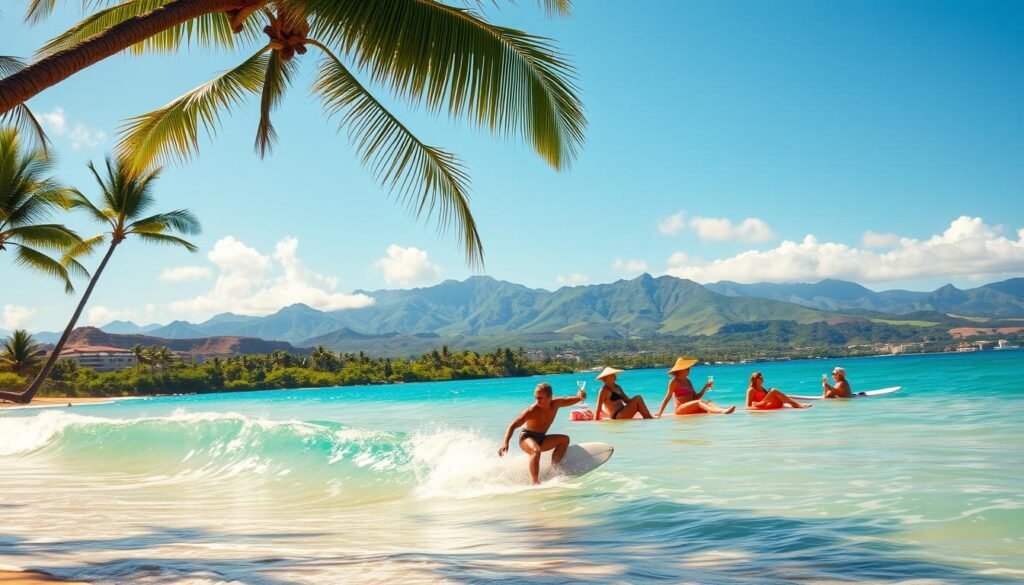
I find July through September rich with classic summer energy—long sunny days, bath‑warm water, and lots of festivals filling the calendar.
July highlights
July brings a lively cultural slate. I watch the Honolulu Surf Film Festival and the Prince Lot Hula Festival for evening performances and local flavor.
Joy of Sake adds a tasty twist for food lovers. Expect steady weather and crowded nights near central venues.
August highlights
August usually has the highest temps and very little rain. South, east, and west waves pick up, but many breaks mellow out for learners.
September highlights
September delivers the warmest ocean water of the year and a festival rush: Aloha Festivals and the Okinawan Festival keep streets active.
Waves can grow medium to large on multiple shores, so conditions vary by beach.
- Summer surges with warm water and gentle south‑shore surf for beginners.
- I plan calm mornings for paddling, then late‑afternoon swims when the sea still feels like a bath.
- Expect more visitors and higher crowds; I lock rentals, surf lessons, and sails early.
- Photographers: late golden hour on calm evenings is prime for beaches and boards.
- If you want a true summer beach vibe, these months are hard to beat.
Tip: For a quick planning check, see my best seasonal guide and lock key bookings well ahead.
Hawaii in October to December: food, film, and holiday surf showdowns
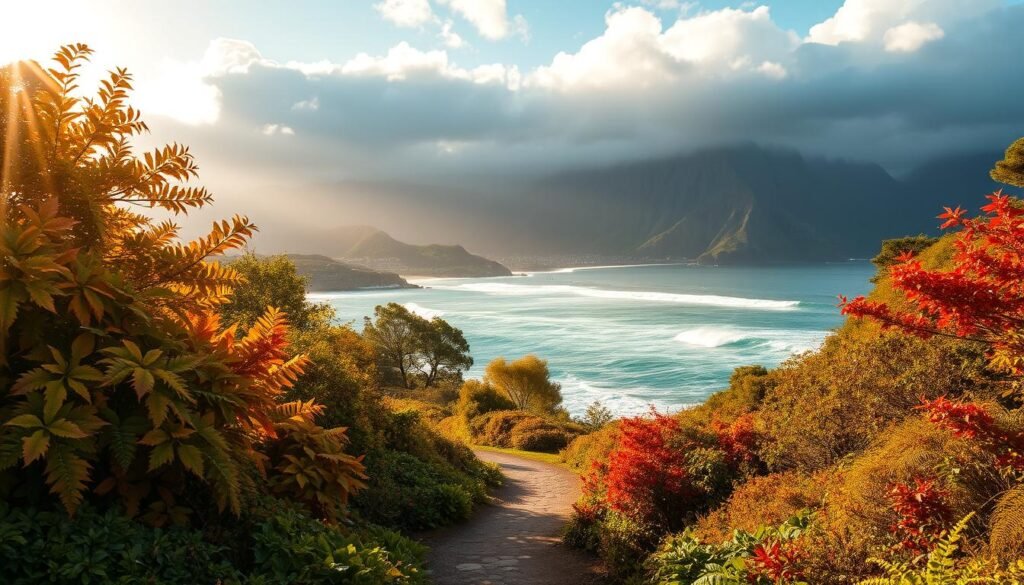
October through December folds food, film, and big surf moments into a compact, lively stretch on the islands.
October kicks off foodie season with the Hawai‘i Food & Wine Festival and the first hint of heavier fall rains. Expect brief showers between sunny stretches; the land stays warm and inviting for outdoor dining and late sunsets.
October: Hawai‘i Food & Wine Festival and rainy season ramp-up
I plan outdoor meals early in the day and keep museum or café options handy if a shower shows up. The festival scene offers strong culinary events and small film tie‑ins across the islands.
November: Vans Triple Crown on the North Shore
November brings the Vans Triple Crown of Surfing to the north shore, a must for surf fans. Temperatures remain pleasant in both air and sea, so I book seats and backup indoor plans for variable conditions.
December: Honolulu City Lights and the Hawaii Bowl
December turns festive with the Honolulu City Lights parade and the Hawaii Bowl football game. Holiday crowds grow, so I lock cars, restaurants, and event tickets ahead of time.
- Plan flexible days: morning surf or festival runs, museum stops for sudden rain, then a golden‑hour sail.
- For better value, target early October or late November shoulder weeks outside major events.
Oʻahu in the fall (September October): lighter crowds, calmer seas, better deals
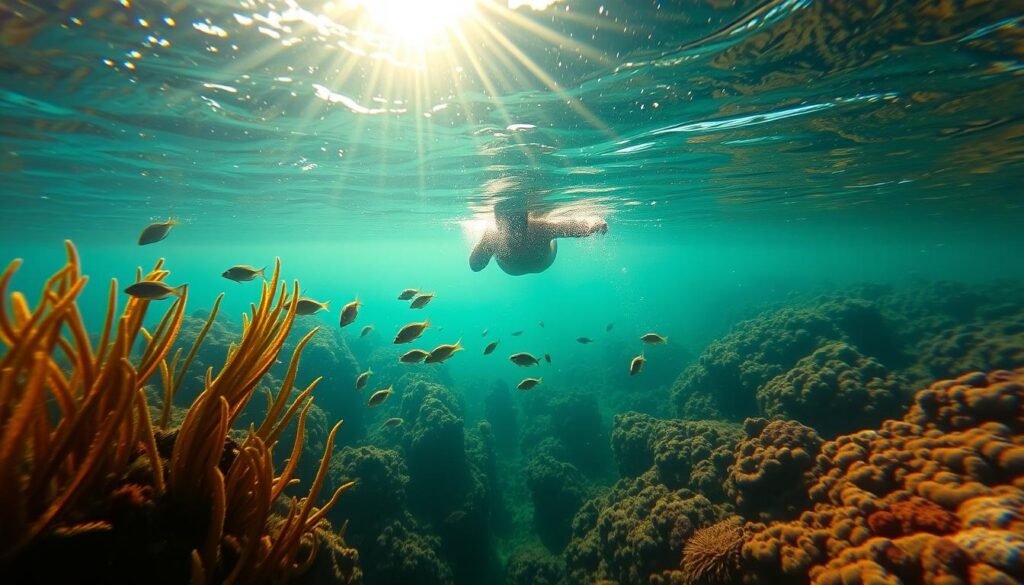
September and October mellow Oʻahu’s pace. Days usually sit around 78–82°F, and the ocean is at its warmest. I find water glassier for snorkeling and great for beginner surf lessons.
Fewer visitors mean Diamond Head, Hanauma Bay, and HoMA feel more relaxed. I plan midweek hikes like Lanikai Pillbox or Aiea Loop to dodge crowds and enjoy cooler trails.
From Waikīkī, I’ll book a Holokai Catamaran or a Hawaii Glass Bottom Boat for golden‑hour sails. Calm seas and clear light make sunsets and reef views shine.
Fall also brings celebrations. Honolulu Pride, Aloha Festivals, the Hawai‘i Food & Wine Festival, and the Hawai‘i International Film Festival offer events and dining nights I don’t want to miss.
- I prioritize morning snorkeling when visibility is highest and afternoons for lazy swims.
- With fewer visitors I hunt hotel deals and often score upgrades or better views.
- Hale‘iwa day trips feel easy—galleries, local plates, then back to Waikīkī for sunset.
- Packing: light layers, reef‑safe sunscreen, comfy shoes, and a small dry bag for boat days.
| Feature | September–October | How I use it |
|---|---|---|
| Temperatures | 78–82°F | Light layers for mornings; beach days midday |
| Ocean conditions | Warmest, calmer | Snorkel mornings; beginner surf in Waikīkī |
| Crowds & deals | Lower; better hotel rates | Book midweek hikes and snag upgrades |
| Events | Pride, Aloha Festivals, Food & Wine, Film | Reserve dinners and festival tickets early |
Surf, swell, and snorkeling conditions by season and shore
I plan water days around swell direction and recent rains, not just the calendar month. Picking the right shore and hour makes a big difference for visibility, gentle entries, and safety.
North vs. south shore patterns through the year
Winter lights up the north and west with large swells and dramatic surf. Those waves are thrilling to watch from safe lookouts, but they make many beaches unsafe for casual swimming.
In summer, south‑facing beaches calm down and offer friendlier ocean conditions. If you want mellow waves or lessons, I point you to these shores during the warm months.
When I plan dives for visibility and gentle entries
For snorkeling, I aim for mornings after a dry stretch. Calm seas and light winds give the best water clarity and easier, sandy entries.
I always check recent rainfall and choose leeward coves when trades strengthen—runoff can cut visibility fast. For safety, I avoid unguarded beaches during winter swells and favor summer reef breaks for beginner paddles.
- Rule of thumb: winter = big north surf; summer = calmer south water.
- Schedule dives after calm spells and before midday winds pick up.
- Use local reports and watchers for current conditions when you pick a spot.
Rainy and hurricane seasons explained: timing, risks, and how I plan
Knowing when showers usually happen lets me schedule big outdoor plans with confidence. I watch the island weather so a short squall doesn’t derail a beach day.
Rainfall rhythm: November–January vs. May–September
The wettest stretch runs November through January. That period brings the most rain and localized heavy downpours.
From May to September I see the driest stretch. Most showers fall overnight or in the early morning, so daytime plans often stay clear.
Hurricane season (June–November) and what I watch
Hurricane season spans June to November, but direct hits are rare. Historical storms like Iniki in 1992 and heavy rains from Lane show why I stay alert.
I monitor long‑range forecasts and El Niño updates since warmer ocean water can change storm odds in a given year.
- Plan for short, localized showers: pack a compact rain shell and a small dry bag for electronics.
- Backup options: museums, cafés, markets, and spas make easy pivots during a passing squall.
- Ocean safety: heed lifeguards and advisories during winter surf or stormy spells.
| Risk | Typical months | My action |
|---|---|---|
| Highest rainfall | Nov–Jan | Plan mornings outdoors; carry rain shell |
| Driest stretch | May–Sep | Book long hikes and boat days |
| Hurricane season | Jun–Nov | Watch forecasts; adjust if a threat appears |
Crowd-savvy planning: securing cars, hotels, and activities
I treat rental cars and key activities like scarce resources—secure them early and build the rest of the trip around those bookings. In high season, visitors climb fast and crowds tighten. That means fleets and ticketed slots disappear before casual browsers know they exist.
When I plan travel, I lock a car first for peak dates. Then I compare refundable hotel rates and direct offers so I can shift if needed. Local events will spike demand at a location, so I keep event dates front and center when I book.
- I hold rental cars early—fleets sell out faster than most expect.
- I pick refundable hotel options and stack loyalty or bundled deals when they add value.
- I reserve snorkel cruises, surf lessons, and luaus soon if I want specific times or front‑row seats.
Quick strategy: avoid the busiest days by visiting top sights at sunrise or midweek. Shoulder season still gives more flexibility, but I book 2–4 months ahead to lock lower rates and prime slots. If you’re planning around an event, build the itinerary backward from those dates to keep options open.
| Priority | When | Why |
|---|---|---|
| Rental car | As soon as dates set | Fleets sell out in high season |
| Hotel | Compare refundable rates | Flexibility + loyalty perks |
| Activities | 2–4 months ahead | Secure the best times and deals |
What I pack by time of year: layers, reef-safe sunscreen, and camera tips
I pack with island microclimates in mind so a sudden shower or brisk sunset never surprises me. Fall on Oʻahu feels warm during the days—around 78–82°F—and the ocean is usually the warmest and calmest of the months.
Day-to-night wardrobe for trade winds and light showers
I keep my kit light and versatile. Breathable tees, a linen button-up, and a breezy sweater handle trade winds and air conditioning.
A compact rain shell covers brief showers, and quick-dry pieces make beach-to-brunch moves easy. I always tuck a lightweight daypack, a microfiber towel, and a small dry bag inside.
- Sun & sea essentials: reef-safe sunscreen, wide-brim hat, polarized sunglasses, and water shoes for snorkeling and rocky entries.
- Comfort items: comfy shoes, a reusable water bottle, and a spare layer for cooler summit breezes or boat shade.
Fall photography: softer light, vibrant sunsets, and rainbows
Fall gives softer light and dramatic sunsets that lift any photo. Post‑shower rainbows and calm evening water create great reflections.
For gear I use a CPL filter to cut glare, a small tripod for low-light sunsets, extra batteries, and a zip pouch for memory cards so I never miss a spontaneous island moment.
| Item | Why I pack it | When I use it |
|---|---|---|
| Light layers | Trade winds & varying temperatures | Day and night |
| Compact rain shell | Handles brief showers | Any wet forecast |
| CPL filter & tripod | Reduce glare; steady low-light shots | Sunset and post-rain reflections |
Quick tip:I aim to keep carry weight low so I can enjoy long days outdoors without lugging excess gear.
Conclusion
,
Conclusion
Let me sum up the essentials so you can lock dates that match the experience you want. Hawaii shines year‑round; your choice depends on what you value most—calm seas, big surf, festivals, or lower costs.
Quick bottom line: for strong value with little trade‑off, aim for early November or late March and book flights and hotel rooms about 2–4 months ahead.
Summer brings warmest water and classic beach days. Winter delivers surf spectacles and whale season. Fall gives softer light, calmer oceans, and steady cultural events.
I encourage flexible planning: secure core bookings early, watch forecasts, and leave room for spontaneous beaches and sunset sails. When you’re ready, lock your dates and let the islands set the pace for your trip.


